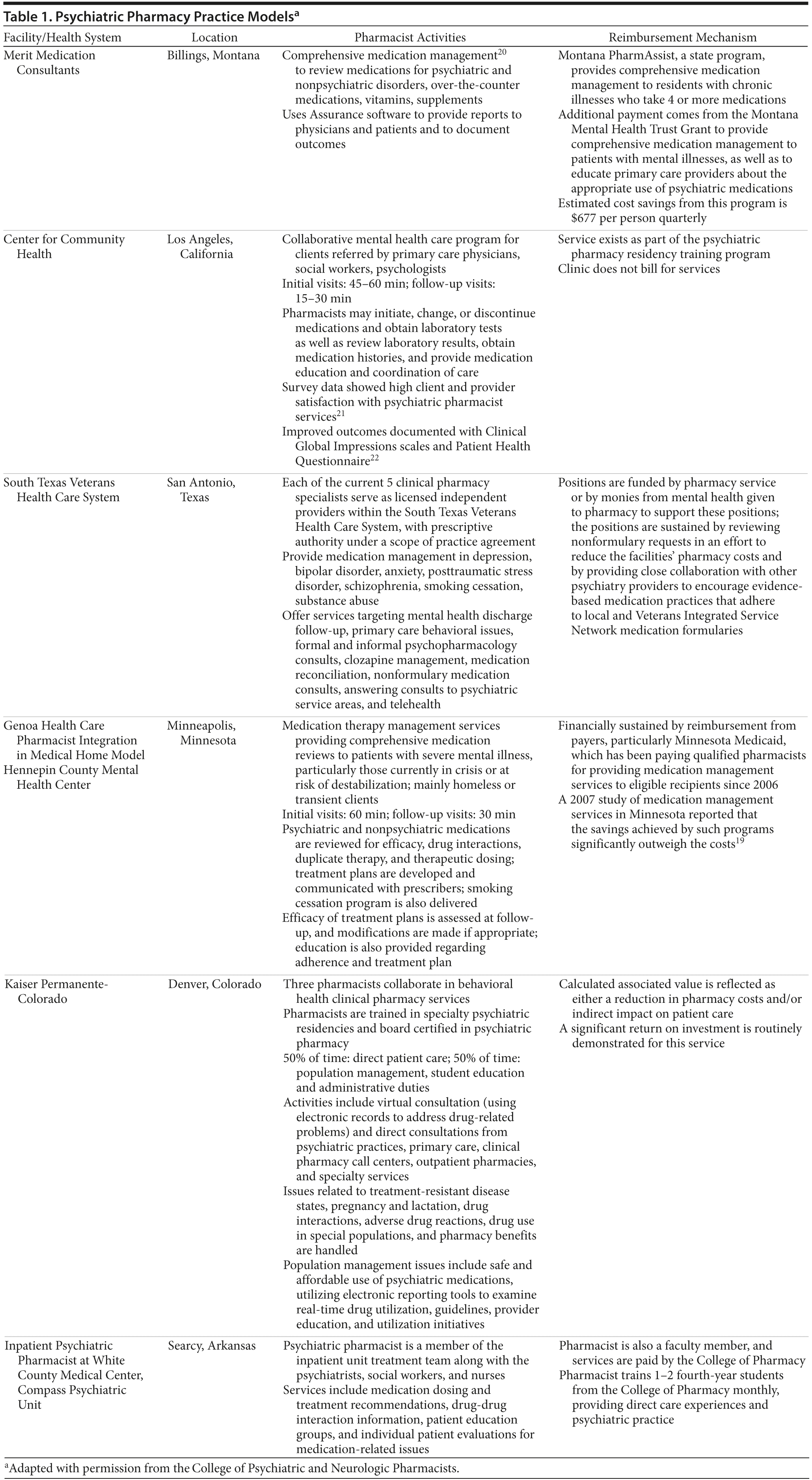Psychiatric Pharmacist Integration Into the Medical Home
Submitted: March 20, 2013; accepted May 3, 2013.
Corresponding author: Jerry R. McKee, PharmD, MS, BCPP, Wingate University Hendersonville, 220 5th Ave E, Hendersonville, NC 28792 ([email protected]).
Published online: August 22, 2013.
Prim Care Companion CNS Disord 2013;15(4):doi:10.4088/PCC.13com01517
© Copyright 2013 Physicians Postgraduate Press, Inc.
People with severe and persistent mental illnesses, such as schizophrenia, often receive inadequate general medical care1–6 and are documented to have a 25-year shorter lifespan than those without serious mental illness.7–10 Individuals with severe and persistent mental illnesses are frequently stigmatized, are often impoverished, frequently have co-occurring alcohol and/or substance use disorders, and are incarcerated in such large numbers that jails and prisons have become the new mental “institutions.”11–14 Additionally, more than 68% of adults with a mental disorder have at least 1 medical condition,8 resulting in decreased quantity and quality of life, increased symptom burden, and increased health care costs.15–17
Due to the long-standing lack of integration between mental health and primary care services, the “Final Report for the President’s New Freedom Commission on Mental Health”8 recommended use of evidence-based models to improve patient care at the interface of general medicine and mental health. Patients often present to their primary care providers with physical complaints; however, careful evaluation determines that, in many instances, the visit is driven by mental health or substance abuse issues. A Center for Health Care Strategies analysis found that, among Medicaid patients with chronic conditions, a comorbid mental health or substance use disorder predicted 60%–75% higher health care costs compared to those without comorbid mental health or substance use disorders. Further, patients with comorbid mental health or substance use disorders were 4 to 5 times more likely to be hospitalized than those without.16 The Center for Health Care Strategies offered ways to address these patient needs including use of multidisciplinary health care teams for patients with multiple complex needs, integration of behavioral health and physical health care, and financial incentives to care integration.
COMPREHENSIVE MEDICATION
MANAGEMENT AND INTEGRATED CARE
One often overlooked solution to the lack of integration of physical and behavioral health care models and the associated dearth of care coordination and related medication management problems is to more effectively utilize appropriately trained pharmacists to support patient-focused care. Engaging patients to promote effective medication management can be accomplished through a multidisciplinary health care team model. Working as part of the team, pharmacists have a unique set of knowledge and skills that are ideal for providing comprehensive medication management. Patients can benefit from pharmacists’ expertise in pharmacology, pharmacokinetics, drug-drug and drug-disease interactions, and optimization of medication adherence. Patients with mental illness can especially benefit from psychiatric pharmacists’ unique training in psychopharmacology and patient education about the risks and benefits of treatment. Psychiatric pharmacists embrace the concept of team-based care that involves the psychiatric and medical team and patient and family members; they also promote patient empowerment in the recovery process.
With the documented significant impact of multiple chronic diseases and medications on health care resource utilization, the benefit of pharmacists’ engagement in medical home medication management has been clearly outlined.18 One of the main benefits of team-based care including comprehensive medication management is to identify patients who are not meeting goals of therapy and to help them achieve those goals. Patients not meeting clinical goals are at an increased risk for emergency department visits or hospital admissions. Comprehensive medication management is effective in solving drug therapy problems to ensure that medications are appropriate, effective, safe, and taken as intended.18,19 A health system structure comprised of providers with distinct knowledge and skills can foster the philosophy of team-based care and ensure a productive, effective medication use system.19 It has been demonstrated that patients who may derive the most benefit from pharmacist engagement are those who have not achieved or maintained therapeutic goals of pharmacotherapy, who may be experiencing adverse medication effects (which may impact adherence), who may have difficulty in understanding and following the medication regimen, and who are frequently admitted or readmitted to the hospital or receive care through emergency departments.20 Unfortunately, many patients with chronic mental and medical illnesses struggle with these medication therapy challenges and need additional support from their health care providers.
The College of Psychiatric and Neurologic Pharmacists (CPNP; http://cpnp.org/) is a national organization with over 1,200 pharmacists who work with patients with mental illness and mental health providers. The CPNP advocates the provision of comprehensive medication management, as defined by the Patient-Centered Primary Care Collaborative.20 Comprehensive medication management includes an assessment of a patient’s medication regimen for indication, effectiveness, safety, and adherence. It employs the tenets of pharmaceutical care, pharmacy’s professional practice, and identifies and provides solutions to a patient’s drug therapy problems. Care should be coordinated among those who provide care for a given patient, and goals of therapy should be communicated among team members, including the patient.18 Comprehensive medication management is a reiterative process. An organized care delivery process can help patients achieve desired drug treatment goals and avoid drug therapy problems that may be impeding progress toward those goals. Examples of practice models that demonstrate improved clinical, economic, and educational outcomes can be found in Table 1.

Board-certified psychiatric pharmacists are uniquely positioned to partner with primary care providers and generalist pharmacists to target patients with complex medical and mental health disorders who are not meeting goals of therapy. Psychiatric pharmacists can provide added clinical, economic, and humanistic value to management of diseases that often lead to treatment nonadherence, high resource utilization, and overall poor quality of life. Clinical pharmacists are currently providing a range of patient-centered services by working directly with patients and families, physicians, psychiatrists, nurses, and social workers. Recognition of pharmacists as clinical service providers and associated payment for services to enable these services to be both financially sustainable and scalable is a goal of the CPNP, which is working with other state and national pharmacy organizations in pursuit of this objective. According to an Institute of Medicine report: “Pharmaceuticals are the most common medical intervention, and their potential for both help and harm is enormous. Ensuring that the American people get the most benefit from advances in pharmacology is a critical component of improving the national health care system.”23(p13)
Presently, at least 18 state Medicaid programs reimburse medication therapy management services that are provided by qualified pharmacists as cited by the National Conference of State Legislatures.24 Published reports, including the “US Public Health Service Report on Advanced Pharmacy Practice to the US Surgeon General,”24–26 suggest that pharmacist-provided medication management services have demonstrated a significant return on investment (as high as 12:1 and an average of 3:1 to 5:1).25–27 By coordinating our efforts within existing or novel patient care models, such as patient-centered medical homes, together we can improve access to care, improve health care–related outcomes, and decrease overall health care costs for patients with mental illness and medical comorbidities. The CPNP has adopted a position statement on the integration of behavioral health and primary care, specifically around the inclusion of pharmacists in the medical home model (http://cpnp.org/govt/position/medical-home-model).
It is clear that there is a shortage of primary care workforce in the United States, and this trend is predicted to increase with the aging population and Medicaid expansion via the Affordable Care Act. The unique skills of the pharmacist complement those of other members of the health care team. Incorporating the clinical pharmacist into a multidisciplinary team can improve efficiency of care. It is estimated that over one-third of primary care provider time is spent on chronic care management. The pharmacist can use comprehensive medication management to allow physicians the opportunity to more effectively use their time in physician-specific patient care activities.28 This can be accomplished by pharmacists who can ensure accurate medication lists for each patient, provide pharmacotherapy recommendations, solve drug therapy problems, and educate patients about their treatment plan. This model also offers the opportunity to improve quality of care endpoints via shared responsibility with the team.28,29 An excellent, comprehensive review of why pharmacists belong in the medical home, and the value to both patients and other team members, has been prepared by Smith and colleagues.30 Further, a recent meta-analysis compiled, analyzed, and reviewed pharmacists’ contributions in this practice arena and found that the use of pharmacists as described above is a viable solution to many of the access to and coordination of care issues in our US health system.31
The issue of payment continues to loom large as a major barrier in the provision of pharmacist-provided primary care services, as effective and sustainable reimbursement models are lacking. As the models highlighted in Table 1 will attest, pharmacists embedded in practices are often funded through pilot programs and demonstration projects or are staffed via academic programs.30 Payment systems must be devised and implemented to support, sustain, and enable growth of this practice model. For large primary care practices, pharmacists may be employed by the practice or may contract for time. Smaller practices may contract for a defined number of hours per week.18,30,32 Primary care physicians and practices with interest may identify collaborating psychiatric pharmacists in their region through the assistance of organizations such as the CPNP and Board of Pharmaceutical Specialties (http://www.bpsweb.org).
In summary, the CPNP supports the integration of psychiatric pharmacists into primary care practices to provide comprehensive medication management as part of an integrated health care team to improve access to care, improve quality of care, decrease costs, and improve provider and patient satisfaction for patients with both serious mental illnesses and chronic medical conditions. The ultimate goal in promoting collaboration between mental and medical care is to improve the lives of persons with chronic mental illness and the lives of their families.
Drug names: clozapine (Clozaril, FazaClo, and others).
Author affiliations: Wingate University School of Pharmacy, Hendersonville, North Carolina (Dr McKee); Skaggs School of Pharmacy and Pharmaceutical Sciences, University of California San Diego, La Jolla, California (Dr Lee); and RiverStone Health, Billings, Montana (Dr Cobb).
Potential conflicts of interest: Dr Cobb has received grant/research support from Montana Mental Health Trust. Drs McKee and Lee report no conflicts of interest related to the subject of this article.
Funding/support: None reported.
Acknowledgments: The authors acknowledge the support of the College of Psychiatric and Neurologic Pharmacists Comprehensive Medication Management Task Force in developing this position statement.
REFERENCES
1. Moeller KE, Rigler SK, Mayorga A, et al. Quality of monitoring for metabolic effects associated with second-generation antipsychotics: effects of practice guideline dissemination in persons with schizophrenia on public insurance. J Pharm Pract. 2010;23(2):150.
2. Morrato EH, Druss B, Hartung DM, et al. Metabolic testing rates in 3 state Medicaid programs after FDA warnings and ADA/APA recommendations for second-generation antipsychotic drugs. Arch Gen Psychiatry. 2010;67(1):17–24. doi:10.1001/archgenpsychiatry.2009.179 PubMed
3. Morrato EH, Nicol GE, Maahs D, et al. Metabolic screening in children receiving antipsychotic drug treatment. Arch Pediatr Adolesc Med. 2010;164(4):344–351. doi:10.1001/archpediatrics.2010.48 PubMed
4. Morrato EH, Newcomer JW, Kamat S, et al. Metabolic screening after the American Diabetes Association’s consensus statement on antipsychotic drugs and diabetes. Diabetes Care. 2009;32(6):1037–1042. doi:10.2337/dc08-1720 PubMed
5. Morrato EH, Newcomer JW, Allen RR, et al. Prevalence of baseline serum glucose and lipid testing in users of second-generation antipsychotic drugs: a retrospective, population-based study of Medicaid claims data. J Clin Psychiatry. 2008;69(2):316–322. doi:10.4088/JCP.v69n0219 PubMed
6. Nguyen D, Brakoulias V, Boyce P. An evaluation of monitoring practices in patients on second-generation antipsychotics. Australas Psychiatry. 2009;17(4):295–299. doi:10.1080/10398560902842519 PubMed
7. Parks J, Svendsen D, Singer P, et al, eds. Morbidity and Mortality in People With Serious Mental Illness. 13th Technical Report. Alexandria, VA: National Association of State Mental Health Program Directors Medical Directors Council; 2006:1–87.
8. Final Report for the President’s New Freedom Commission on Mental Health. Achieving the Promise: Transforming Mental Health Care in America. Vol SMA 03-3832. Substance Abuse and Mental Health Services Administration: SAMHSA’s National Mental Health Information Center; 2003:1–84.
9. Jennex A, Gardner DM. Monitoring and management of metabolic risk factors in outpatients taking antipsychotic drugs: a controlled study. Can J Psychiatry. 2008;53(1):34–42.
10. Meyer JM, Davis VG, McEvoy JP, et al. Impact of antipsychotic treatment on nonfasting triglycerides in the CATIE schizophrenia trial phase 1. Schizophr Res. 2008;103(1–3):104–109. doi:10.1016/j.schres.2008.04.023 PubMed
11. Butterfield F. Asylums behind bars: a special report; prisons replace hospitals for the nation’s mentally ill. New York Times. March 5, 1998.
12. James DJ, Glaze LE. Mental Health Problems of Prison and Jail Inmates. Bureau of Justice Statistics Special Report; September 2006:1–12. US Department of Justice Office of Justice Programs Web site. http://www.bjs.gov/index.cfm?ty=pbdetail&iid=789. Accessed July 14, 2013.
13. Lamb HR, Bachrach LL. Some perspectives on deinstitutionalization. Psychiatr Serv. 2001;52(8):1039–1045. doi:10.1176/appi.ps.52.8.1039 PubMed
14. Lurigio AJ, Swartz JA. Changing contours of the criminal justice system to meet the needs of persons with serious mental illness. In: Horney J, ed. Policies, Processes, and Decisions of the Criminal Justice System. Washington, DC: Department of Justice; 2000:45–108.
15. Druss BG, Walker ER. Mental Disorders and Medical Comorbidity. The Synthesis Project; Research Synthesis Report no. 21; February 2011:1–26. http://www.rwjf.org/en/research-publications/find-rwjf-research/2011/02/mental-disorders-and-medical-comorbidity.html. Accessed July 14, 2013.
16. Boyd C, Leff B, Weiss C, et al. Faces of Medicaid: Clarifying Multimorbidity Patterns to Improve Targeting and Delivery of Clinical Services for Medicaid Populations. Data Brief; December 2010:1–14. Center for Health Care Strategies Web site. http://www.chcs.org/publications3960/publications_show.htm?doc_id=1261201. Updated December 2010. Accessed July 14, 2013.
17. Croghan TW, Brown JD. Integrating Mental Health Treatment Into the Patient Centered Medical Home. Mathematica Policy Research. AHRQ Publication No. 10-0084-EF ed. Rockville, MD: Agency for Healthcare Research and Quality; 2010.
18. Isetts BJ, Brummel AR, de Oliveira DR, et al. Managing drug-related morbidity and mortality in the patient-centered medical home. Med Care. 2012;50(11):997–1001. doi:10.1097/MLR.0b013e31826ecf9a PubMed
19. Isetts BJ, Schondelmeyer SW, Artz MB, et al. Clinical and economic outcomes of medication therapy management services: the Minnesota experience. J Am Pharm Assoc (2003). 2008;48(2):203–211, 3, 211. doi:10.1331/JAPhA.2008.07108 PubMed
20. McInnis T, Webb CE, Strand LM. The Patient Centered Medical Home: Integrating Comprehensive Medication Management to Optimize Patient Outcomes. 2nd Edition. Patient-Centered Primary Care Collaborative; June 2012:1–28. http://www.pcpcc.net/guide/patient-health-through-medication-management. Accessed July 14, 2013.
21. Chung B, Dopheide JA, Gregerson P. Psychiatric pharmacist and primary care collaboration at a skid-row safety-net clinic. J Natl Med Assoc. 2011;103(7):567–574. PubMed
22. Wang I, Dopheide JA, Gregerson P. The role of a psychiatric pharmacist in a skid-row safety net clinic in Los Angeles. J Urban Health. 2011; 88(4):718–723. doi:10.1007/s11524-011-9573-6 PubMed
23. Institute of Medicine, National Academy of Sciences. Informing the Future: Critical Issues in Health. 4th Edition. The National Academies Press; 2007:1–120.
24. Medication Therapy Management: Pharmaceutical Safety and Savings. National Conference of State Legislatures Web site. http://www.ncsl.org/issues-research/health/medication-therapy-management.aspx. Updated March 2012. Accessed July 14, 2013.
25. Giberson S, Yoder S, Lee MP. Improving Patient and Health System Outcomes Through Advanced Pharmacy Practice. A Report to the US Surgeon General. Office of the Chief Pharmacist; US Public Health Service; December 2011:1–95.
26. Schumock GT, Meek PD, Ploetz PA, et al; The Publications Committee of the American College of Clinical Pharmacy. Economic evaluations of clinical pharmacy services: 1988–1995. Pharmacotherapy. 1996;16(6):1188–1208. PubMed
27. Perez AD, Doloresco F, Hoffman JM. Economic evaluations of clinical pharmacy services: 2001–2005. Pharmacotherapy. 2009;29(1):128. doi:10.1592/phco.29.1.128 PubMed
28. Ghorob A, Bodenheimer T. Sharing the care to improve access to primary care. N Engl J Med. 2012;366(21):1955–1957. doi:10.1056/NEJMp1202775 PubMed
29. Grumbach K, Bodenheimer T. Can health care teams improve primary care practice? JAMA. 2004;291(10):1246–1251.
30. Smith MA, Bates DW, Bodenheimer TS, et al. Why pharmacists belong in the medical home. Health Aff (Millwood). 2010;29(5):906–913. doi:10.1377/hlthaff.2010.0209 PubMed
31. Chisholm-Burns MA, Kim Lee J, Spivey CA, et al. US pharmacists’ effect as team members on patient care: systematic review and meta-analyses. Med Care. 2010;48(10):923–933. doi:10.1097/MLR.0b013e3181e57962 PubMed
32. Smith MA. Pharmacists and the primary care workforce. Ann Pharmacother. 2012;46(11):1568–1571. doi:10.1345/aph.1R438 PubMed





